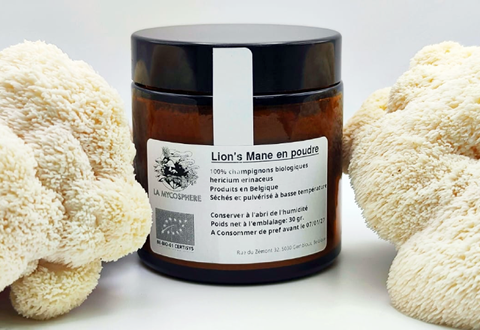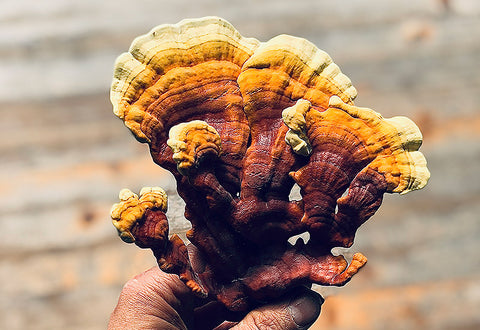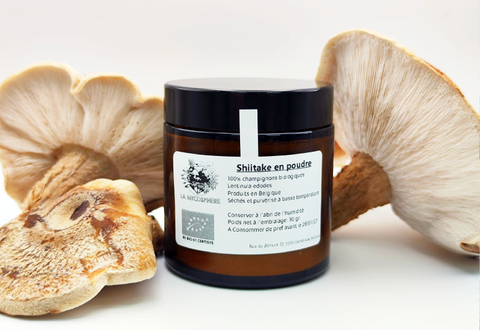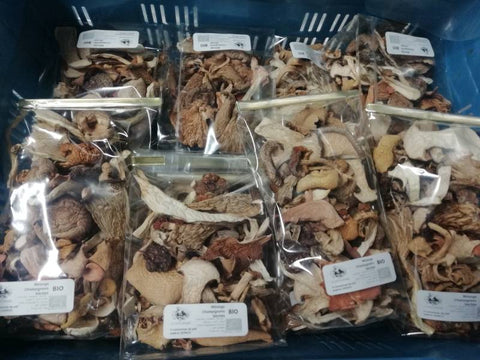Chaga Bio of the Boreal Forests
- 🍄 AVAILABLE IN POWDER OR PIECES : Ideal for preparing your own chaga-based infusions.
- 🌱 WILD AND SUSTAINABLE HARVEST: Mushrooms carefully hand-picked in their natural habitat, ensuring an environmentally friendly approach.
- 💪 NATURAL SOURCE OF NUTRIENTS : Contains beneficial compounds such as beta-glucans, vitamin B, and other essential micronutrients.
- ☕ UNIQUE FLAVOR : Enjoy its woody and slightly bitter taste, an original alternative for your hot drinks.
The mushroom
Inonotus obliquus or Oblique Polypore
Discover the unique benefits of chaga, a mushroom with multiple advantages for your well-being!
The chaga has been used for centuries in Nordic traditions. This mushroom mainly grows on birch trees in the boreal and subarctic regions of the planet. These regions notably include Siberia, Scandinavia, northern Europe, Canada, and Alaska.
In these cold climates, birch trees provide a favorable environment for the growth of chaga. The fungus often establishes itself on aging or weakened birch trees, taking advantage of their hard bark and spongy interior to develop.

It appears as a black, lumpy mass, resembling coal or burnt bark. Inside this dark outer mass lies a treasure of health benefits.
Benefits
Chaga contains a variety of nutrients and beneficial compounds, such as B vitamins, minerals like potassium, zinc, and iron, as well as antioxidants such as polyphenols, melanin, and beta-glucans.
In ancestral traditions, chaga is often valued for its beneficial properties. It is traditionally used to support overall well-being and is reputed for its potential to soothe and comfort. Some practices suggest that it may contribute to internal balance when incorporated into an appropriate routine, such as decoctions.
Important :
This information is shared for educational and cultural purposes. The specific benefits of chaga on the immune system, digestive system, or any other aspect of health have not been scientifically validated under European health regulations. For any questions or additional information, please consult a healthcare professional.
Its delicate aroma recalls notes of undergrowth: earthy and woody notes, slightly bitter. Some compare it to that of coffee or black tea, but it has its own distinct flavor. It can be pleasantly used as a substitute for coffee. Note: it contains neither theine nor caffeine.
Why extract chaga?
The extraction of chaga, whether done with hot water (decoction) or alcohol (tincture), is essential to maximize the benefits of this mushroom due to several factors:
-
Absorption of active compounds: Chaga contains bioactive compounds such as beta-glucans, antioxidants (like superoxide dismutase), and betulinic acid. These compounds are better released and absorbed by the body when the powder is extracted in hot water or alcohol.
-
Durability of compounds: The cell walls of chaga are made of chitin, a substance difficult for humans to digest. Hot water or alcohol extraction breaks down this barrier and makes the beneficial compounds more bioavailable, thereby increasing the product's effectiveness.
-
Safe consumption: Although consuming raw powder is not dangerous in itself (but chaga is not considered a food in itself), extraction allows concentrating the active ingredients, thus offering a more effective product that is potentially more beneficial for the body.
We offer chaga in two forms:
-
The powder is easier to use because it can be directly added to infusions and other preparations. It requires a shorter infusion time, which allows for a faster extraction of active compounds.
-
The pieces have the advantage of being less sensitive to oxidation and therefore better preserve their qualities for long-term storage. When brewed, the pieces require a longer infusion time, but they can be used for multiple infusions, allowing you to enjoy their benefits over a longer period.
The origin and the harvest
Our chaga harvests are carried out with a view to sustainable resource management, which notably involves:
-
Responsible harvesting: Harvesters ensure that only a portion of the mushrooms is collected. They always leave a minimum quantity of mushrooms to allow for their regeneration.
-
Rotation of harvesting sites: Harvesters avoid collecting chaga repeatedly from the same spot. They move to different forest areas to allow the mushrooms to regenerate in previously harvested zones.
-
Respect for host trees: Chaga grows on living trees, mainly birch. Harvesters ensure not to damage the tree during the collection of the mushroom and to only harvest mature chaga while preserving the health of the host tree.
-
Use of manual methods: Manual harvesting of chaga is preferred in order to minimize damage to the tree and its environment. The tools used are often knives or axes to carefully collect the fungus without causing excessive damage.
-
Compliance with local regulations: Harvesters comply with local laws and regulations regarding the harvesting of wild mushrooms. This includes harvest quotas, specific harvesting periods, or protected areas where harvesting is prohibited.
-
Encouragement of natural regeneration: Harvesters promote the natural regeneration of chaga by protecting previous harvesting areas and allowing the mushrooms to spread and reproduce naturally.

These practices aim to maintain ecological balance while allowing for responsible and sustainable harvesting of chaga, thus ensuring the continued availability of this precious mushroom in the years to come.
After harvesting and before storage, sorting is done to eliminate pieces that do not meet quality criteria and also to remove as many pieces of bark and wood as possible to maximize the purity and quality of the product.
Our chaga is certified organic and of European origin.
Use
Product intended exclusively for the preparation of decoctions or extractions for personal use. Do not consume directly.
Here are some common methods to use chaga:
1. Chaga infusion

Infusion remains one of the most popular ways to use chaga. To prepare it, simmer pieces of chaga or chaga powder in water for 15 to 20 minutes. Then strain the liquid and consume it hot or cold. For a more pleasant taste, add honey, lemon, or other natural sweeteners.
- Recommended dosage: 1 to 3 teaspoons of chaga powder per day (approximately 2 to 6 grams).
- Usage advice: Consume in the morning or at noon, preferably at mealtime. Limit yourself to 1 to 2 cups per day to avoid excessive consumption of oxalic acid.
2. Chaga mother tincture
Alcohol extraction allows concentrating the properties of chaga, particularly the compounds that are not soluble in water. To prepare a tincture, place pieces of chaga in a glass jar and cover them with strong alcohol (preferably food-grade ethanol, but rum or vodka can also be suitable). Let the mixture rest in a dark place for 3 to 6 weeks, shaking regularly.
- Recommended dosage: A few drops to 1/2 teaspoon of tincture, diluted in water or another beverage, 1 to 3 times a day.
Additional tips
- Consumption cycles: To optimize the benefits of chaga, do treatments lasting 2 to 4 weeks, followed by a break of at least 2 weeks before starting again. This allows your body to rest and prevents an overload of oxalic acid.
- Consult a professional: The quantity and frequency of use may vary depending on individual needs and any health conditions. It is recommended to consult a healthcare professional before adding chaga or any other supplement to your routine.
Here is a video in English about preparation by hot water infusion.
Composition:
100% whole dried Chaga (no additives, no substrates in our powders).
100% natural product, raw, vegan, without additives, lactose-free, and gluten-free.
Raw unprocessed product. Handle with care and according to traditional uses.
Average nutritional analysis
| Nutrients | Values |
|---|---|
| Energy (kJ/kcal) | ~320 kcal |
| Fats | <1g |
| don't saturated fatty acids | <0.1g |
| Carbohydrates | 75-80g |
| including sugars | n/a |
| Fibers | n/a |
| Proteins | 4-5g |
| Cell | Very weak |
Sources and references on chaga:
- Powell, M. (2015). Medicinal Mushrooms - A Clinical Guide.
- D, D. R. P. (2020b). Everything about Chaga Mushroom : Everything You Need TO Know About The Most Potent Medicinal Mushroom : History, Cultivation, Uses, Edibles, Recipe and Health Benefits.
- Alhallaf, W.; Perkins, L.B. The Anti-Inflammatory Properties of Chaga Extracts Obtained by Different Extraction Methods against LPS-Induced RAW 264.7. Molecules 2022, 27, 4207. https://doi.org/10.3390/molecules27134207
-
Szychowski KA, Skóra B, Pomianek T, Gmiński J. Inonotus obliquus - from folk medicine to clinical use. J Tradit Complement Med. 2020 Aug 22;11(4):293-302. doi: 10.1016/j.jtcme.2020.08.003. PMID: 34195023; PMCID: PMC8240111.
-
Ye X, Wu K, Xu L, Cen Y, Ni J, Chen J, Zheng W, Liu W. Methanol extract of Inonotus obliquus improves type 2 diabetes mellitus through modifying intestinal flora. Front Endocrinol (Lausanne). 2023 Jan 6;13:1103972. doi: 10.3389/fendo.2022.1103972. PMID: 36686454; PMCID: PMC9852891.
- Lu Yangpeng, Jia Yanan, Xue Zihan, Li Nannan, Liu Junyu, Chen Haixia, Recent Developments in Inonotus obliquus (Chaga mushroom) Polysaccharides: Isolation, Structural Characteristics, Biological Activities and Application, Polymers, 13, 9, 2021.
- Duru, K.C.; Kovaleva, E.G.; Danilova, I.G.; van der Bijl, P. The pharmacological potential and possible molecular mechanisms of action of Inonotus obliquus from preclinical studies. Phytotherapy Res. 2019, 33, 1966–1980.*
- ORAC scale: https://fr.wikipedia.org/wiki/ORAC_(indice)
Conservation:
2 years in a waterproof container, protected from moisture.









